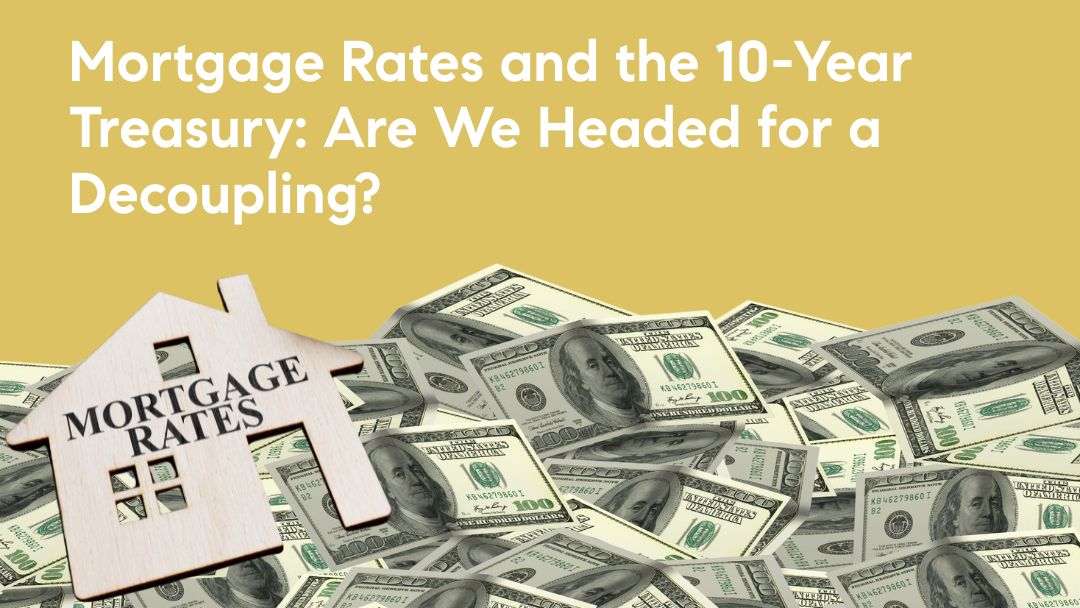As a Berkeley real estate professional, I keep a close eye on mortgage rate trends because they directly impact homebuyer affordability, market activity, and pricing. Traditionally, 30-year fixed mortgage rates have closely followed the yield on the 10-year U.S. Treasury bond. But as global tensions rise—particularly with the U.S.-China trade war escalating—there are growing signs that this long-standing relationship may be at risk of unraveling.
In this article, I explore why mortgage rates are typically tied to the 10-year Treasury, what a potential decoupling could mean for homebuyers and sellers here in Berkeley, and how I expect mortgage rates to behave over the next 18 months if foreign investors continue to divest from U.S. debt.
Why Mortgage Rates Follow the 10-Year Treasury
At the core, it comes down to risk and return. The 10-year Treasury bond has been considered one of the safest investments—it’s backed by the U.S. government and historically has an extremely low risk of default. Because of that, its yield has become a benchmark for many other financial products, including mortgage-backed securities (MBS), which are bundles of home loans sold to investors.
When an investor is choosing between buying a 10-year Treasury bond or investing in a pool of mortgages, they expect a higher return from the mortgages because they carry more risk—borrowers might default, or refinance if interest rates drop. But investors don’t want wildly unpredictable returns, so they use the 10-year Treasury yield as a baseline. They’ll demand a yield on MBS that’s somewhat higher than the 10-year Treasury yield to compensate for the added risk and complexity, but the two tend to move in tandem.
The 30-year fixed mortgage is the most common loan product in the U.S., but few investors want to hold something for 30 years. In practice, most mortgages are refinanced, paid off, or otherwise turned over after about 7–10 years, which makes the 10-year Treasury a closer duration match for those investments than the 30-year bond. So, when the yield on the 10-year Treasury goes up—usually because of expectations for higher inflation or economic growth—mortgage rates typically rise as well, because investors now demand a higher yield on mortgage-backed securities too. Mortgage rates typically trade at a spread of 1.5% to 2% above the 10-year Treasury yield.
That said, the relationship isn’t one-to-one. Mortgage rates also reflect other factors like Federal Reserve policy, global demand for U.S. debt, the supply of mortgages being originated, credit risk perceptions, and the level of competition among lenders. But broadly, the 10-year Treasury yield serves as a foundational anchor point for where mortgage rates are likely to go.
In short: mortgage rates track the 10-year Treasury yield because it reflects the cost of long-term money in the U.S. economy, and it’s the benchmark against which investors price the risk and return of mortgage-backed investments.
What Happens in a Trade War?
In a trade war, particularly one involving China—which holds over $700 billion in U.S. Treasury securities—there’s a real risk that foreign investors will reduce their holdings in U.S. government debt. These foreign investors sell their U.S. debt which push Treasury prices down and yields up. The U.S. government needs to offer higher yields (i.e. interest) in order to entice investors to continue to purchase the bonds that many others are selling. Typically, rising Treasury yields would lead to higher mortgage rates.
But here’s where it gets interesting: that connection isn’t guaranteed.
A shift in global capital flows, changing investor risk appetites, or direct intervention by the Federal Reserve (such as quantitative easing or buying MBS) could cause mortgage rates to move independently from Treasury yields. We’ve seen this dynamic before, notably during the COVID-19 pandemic, when the Federal Reserve purchased MBS to keep mortgage rates low despite volatility in Treasury markets.
Are We Seeing Signs of Decoupling
The current geopolitical climate is contributing to an erosion of confidence in U.S. debt. As global investors reassess their exposure to Treasuries, the market is experiencing higher yields. Meanwhile, mortgage lenders may face conflicting pressures. On the one hand, higher yields typically raise the cost of capital. On the other, housing market fundamentals, borrower demand, and risk tolerance among MBS investors may temper how high mortgage rates can go.
We’ve already seen the spread between mortgage rates and 10-year Treasuries widen during volatile periods. For example, in late 2022 and early 2023, the spread surged above 3%, a clear sign that lenders were pricing in risk unrelated to Treasury yields.
What Benchmark Might Replace Treasuries?
The 10-year U.S. Treasury note has long served as the benchmark for mortgage-backed securities (MBS) due to its duration and liquidity, but it’s not a perfect fit—especially as mortgage durations shift with interest rate and prepayment dynamics. Alternatives like the 5-year or 7-year Treasury notes may better match the average life of MBS, particularly in periods of elevated refinancing. Other options include using the 10-year swap rate, which aligns more closely with how institutional investors hedge MBS, or the emerging SOFR curve, which is gaining traction as a risk-free rate benchmark in the post-LIBOR era.
More nuanced approaches include composite benchmarks blending different Treasury durations or relying on real mortgage rate indices, though these are harder to standardize or use for hedging. As markets evolve—especially with the Fed scaling back MBS holdings and volatility in the Treasury market—there’s a growing case for moving away from the 10Y Treasury as the default benchmark. A shift toward swap-based or SOFR-based curves may offer a more precise and forward-looking reference, especially as technology enables better modeling of MBS duration and convexity risk.
While I don’t know what benchmark may replace the 10Y treasury, I’m keeping a close eye on the bond markets to help advise my clients on what mortgage rates may look like in the months and years ahead.
Forecasting Mortgage Rates: 2025 and Beyond
Assuming that Treasury yields continue to rise due to foreign sell-offs and domestic fiscal concerns, what might we expect for mortgage rates?
Here’s how I forecast mortgage rates may behave over the next 18 months:
- Short-Term (Spring to Summer 2025): Mortgage rates are likely to rise modestly, potentially reaching 7.25% to 7.75%, especially if the 10-year Treasury yield climbs to 5% or more. However, strong demand for MBS from domestic buyers could cushion the increase.
- Mid-Term (Fall 2025): As the Fed potentially resumes easing in response to economic slowing, and inflation cools further, mortgage rates could stabilize or even decline slightly, perhaps back toward the 6.5% to 7% range.
- Long-Term (Into 2026): If the Treasury market undergoes a structural shift—either through de-dollarization or persistent foreign divestment—mortgage rates could decouple more significantly. This could lead to rates that are either surprisingly resilient (if MBS remain attractive) or unexpectedly high (if investor risk aversion deepens).
For buyers in Berkeley, this means being prepared for continued rate volatility, and possibly a break from traditional rate indicators. As always, strategic timing and expert guidance will be essential.
What This Means for Berkeley Real Estate
In a high-cost market like Berkeley, rate sensitivity is acute. Many buyers stretch to afford even entry-level homes. As such, any move higher in rates can cool demand, particularly among first-time buyers or those without significant equity.
However, I believe Berkeley’s housing market has some built-in protections:
- Strong demand from tech professionals and academics
- Limited housing supply
- A resilient local economy
While we may see some softening at the margins, I don’t expect a dramatic price collapse. Instead, we could see homes staying on the market longer, more contingent offers, and perhaps a modest increase in price reductions—especially for properties that are not move-in ready.
For sellers, it will be crucial to price accurately, stage effectively, and market with precision. For buyers, flexibility and creative financing solutions (like adjustable-rate mortgages or buydown programs) may help mitigate rate pressure.
Final Thoughts
The traditional link between mortgage rates and the 10-year Treasury yield has been a reliable anchor for decades. But in today’s evolving global landscape, that connection may weaken. For the Berkeley market, this adds an element of uncertainty but also opportunity—especially for those who are well-informed and quick to adapt.
If you’re planning to buy or sell in the next year or two, I’d love to help you navigate this changing environment with clarity, insight, and a strategy tailored to your goals.
For more resources on the Berkeley real estate market, mortgage trends, and buying or selling a home, visit my blog or contact me directly.




